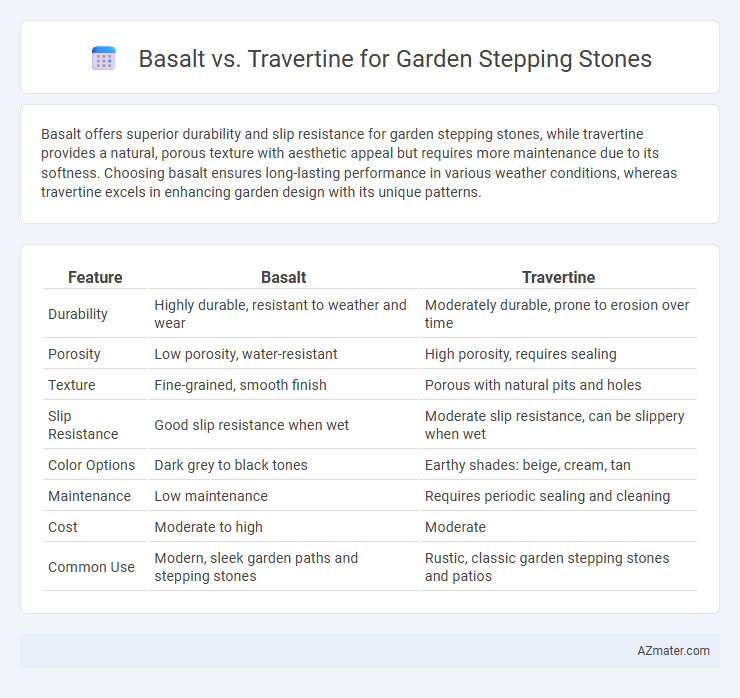Basalt offers superior durability and slip resistance for garden stepping stones, while travertine provides a natural, porous texture with aesthetic appeal but requires more maintenance due to its softness. Choosing basalt ensures long-lasting performance in various weather conditions, whereas travertine excels in enhancing garden design with its unique patterns.
Table of Comparison
| Feature | Basalt | Travertine |
|---|---|---|
| Durability | Highly durable, resistant to weather and wear | Moderately durable, prone to erosion over time |
| Porosity | Low porosity, water-resistant | High porosity, requires sealing |
| Texture | Fine-grained, smooth finish | Porous with natural pits and holes |
| Slip Resistance | Good slip resistance when wet | Moderate slip resistance, can be slippery when wet |
| Color Options | Dark grey to black tones | Earthy shades: beige, cream, tan |
| Maintenance | Low maintenance | Requires periodic sealing and cleaning |
| Cost | Moderate to high | Moderate |
| Common Use | Modern, sleek garden paths and stepping stones | Rustic, classic garden stepping stones and patios |
Introduction: Choosing the Right Stone for Garden Stepping Stones
Basalt offers a dense, durable surface with a natural dark hue that resists weathering, making it ideal for high-traffic garden stepping stones. Travertine provides a lighter, porous texture with warm earth tones, delivering slip resistance and a classic aesthetic for garden pathways. Selecting between basalt and travertine depends on the desired durability, color palette, and texture to enhance garden functionality and visual appeal.
Basalt Stepping Stones: Key Characteristics
Basalt stepping stones offer exceptional durability and resistance to weathering, making them ideal for garden pathways exposed to varying climates. Their dense, fine-grained texture provides a non-slip surface that enhances safety, while the natural dark gray to black hues create a striking contrast in garden landscapes. Basalt's volcanic origin contributes to its strength and longevity, ensuring low maintenance and lasting aesthetic appeal.
Travertine Stepping Stones: Key Features
Travertine stepping stones offer a natural, porous texture that provides excellent slip resistance, making them ideal for garden pathways. Their warm, earthy tones range from creamy whites to rich ochres, enhancing garden aesthetics with a timeless Mediterranean appeal. Durable and weather-resistant, travertine withstands outdoor conditions while developing a beautiful patina over time.
Durability and Longevity Comparison
Basalt stepping stones offer exceptional durability due to their dense, hard volcanic rock composition, making them highly resistant to cracking and weathering in garden settings. Travertine, while aesthetically pleasing with its porous texture, is more prone to erosion and surface wear over time, especially in harsh climates or high-traffic areas. For long-lasting garden pathways, basalt's superior strength and low maintenance requirements provide a more durable and enduring option compared to travertine.
Slip Resistance and Safety Considerations
Basalt offers excellent slip resistance due to its naturally rough and textured surface, making it a safer option for garden stepping stones in wet or icy conditions. Travertine, while aesthetically appealing with its smooth and porous finish, tends to be more slippery when wet, requiring additional treatment or sealing to enhance safety. Prioritizing slip resistance and proper installation ensures safer pathways, especially in gardens exposed to regular moisture or foot traffic.
Maintenance Requirements: Basalt vs Travertine
Basalt stepping stones require minimal maintenance due to their dense, non-porous nature, which resists staining and weathering effectively. Travertine, being more porous, demands regular sealing to prevent water absorption, staining, and erosion, especially in outdoor garden settings. Routine cleaning with a mild detergent and prompt attention to spills are essential for preserving the appearance and durability of travertine stones.
Aesthetic Appeal and Design Versatility
Basalt offers a sleek, modern aesthetic with its dark, uniform texture, enhancing contemporary garden designs and providing excellent contrast against greenery. Travertine features warm, earthy tones and natural pitted textures, lending a rustic, Mediterranean charm that complements traditional and Mediterranean-style landscapes. Both stones provide durable stepping options, but basalt's consistent color and smooth surface maximize design versatility, while travertine's varied patterns create a unique focal point in outdoor spaces.
Climate Suitability and Weather Resistance
Basalt stepping stones offer superior durability and weather resistance, making them ideal for gardens in regions with harsh climates, including heavy rainfall, frost, and extreme temperature fluctuations. Travertine, while aesthetically pleasing and cooler underfoot in hot climates, is more porous and can absorb moisture, leading to potential cracking or erosion in colder, freeze-thaw weather conditions. Choosing basalt ensures long-lasting performance in wet and cold weather, whereas travertine is best suited for mild, dry climates to maintain its structural integrity.
Cost Comparison: Basalt vs Travertine
Basalt stepping stones typically cost between $10 and $20 per square foot, offering a durable and weather-resistant option for garden pathways. Travertine, on the other hand, ranges from $15 to $30 per square foot, reflecting its natural aesthetic appeal and softer texture. Choosing basalt provides a more budget-friendly solution without compromising strength, whereas travertine commands a higher price due to its classic look and unique porous surface.
Final Verdict: Best Choice for Garden Stepping Stones
Basalt offers unmatched durability and slip resistance, making it ideal for high-traffic garden pathways, while travertine provides a warm, natural aesthetic with moderate durability suitable for decorative stepping stones. Basalt's dense, fine-grained structure withstands harsh weather and heavy use better than travertine's porous surface, which requires regular sealing to prevent damage. For a combination of longevity, safety, and low maintenance, basalt is the best choice for garden stepping stones.

Infographic: Basalt vs Travertine for Garden Stepping Stone
 azmater.com
azmater.com